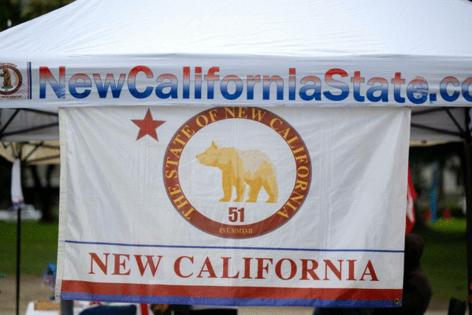Robin Epley: California dreamin' -- of independence: Could the Golden State ever secede?
Published in Op Eds
SACRAMENTO, Calif. — If you, like me, in recent days have wistfully considered a utopian fantasy where an economically powerful country of California breaks away from the chaos of a second Donald Trump presidency, then I have both good news and bad news for you:
The good news is that the fantasy seems to be rapidly gaining support. A new YouGov poll of 500 California adults, commissioned by the Independent California Institute last month, reports a record high 44% who say they would vote for the state to secede from America and become a fully independent nation.
The bad news? There’s no such thing as a Californian utopia in fantasy or reality (and certainly not one where the likes of Gov. Gavin Newsom is in charge). California’s secession from the union would be so impossible as to be nearly “apocalyptic,” according to one of the nation’s top constitutional scholars.
“It is not surprising that talk of secession in California has increased in recent weeks,” wrote the dean of UC Berkeley’s School of Law, Erwin Chemerinsky. “Ultimately, though, the question is whether the federal government would allow California to secede.”
“At this point, it is inconceivable that the federal government would permit this and allow the United States government to come apart,” Chemerinsky said in an email.
“President Trump already has shown a willingness to use the United States military within the state. I imagine there would be a military takeover of California in some way, as occurred in the South in the Civil War. The path without consent of the federal government is apocalyptic.”
The country of California?
This certainly isn’t the first time Californians have considered breaking away.
Notably, the partition of Southern California from the northern part of the state has been a topic of debate since even before California was admitted as a state in 1850. From the Pico Act of 1859, that sought to split the busy north state apart from the then-lightly populated counties of southern California; to the indomitable efforts of northern State of Jefferson supporters; to the New California movement that seeks to razor off Sacramento and the west coast, and the burgeoning CalExit secession movement — California has always wrestled with its size and identity in the larger picture of America.
But there’s something in the air these days that makes the idea feel decreasingly bonkers.
Perhaps that’s because “President Trump is literally fighting a war against California,” Chemerinsky said.
“(Trump) has said that he wants to use the military to ‘liberate’ Los Angeles. He has deployed troops against the desires of the state and city. He has threatened to cut off all funds to California, even though the state pays more in taxes than it receives in federal money. Not surprisingly, then, many are saying they don’t want to be ruled by him,” the nation’s leading constitutional scholar asserted.
In that same spirit, a group advocating for the state’s secession is now attempting to gather enough signatures to place the question on voters’ ballots next year: “Should California leave the United States and become a free and independent country?”
The CalExit group needs 500,000 signatures before July 22 to qualify for the November 2026 ballot, but has currently garnered less than half of the required amount. Yet, the man behind the effort remains hopeful.
“We are further along in the last month and a half than I have been in 10-plus years,” said Marco Ruiz Evans, a Fresno native and California secession advocate who co-founded the CalExit movement.
Evans said the idea of California secession saw a large boost in interest after the Palisades Fire in January: “People (were) in a chaotic, horrible situation … and Donald Trump basically said, ‘I’m not sure I want to send disaster assistance because I’m not sure I like you guys,’” Evans said. “People were shocked that politics would come into play for disaster assistance.”
The Independent California Institute, a libertarian think tank based in Oakland, reported in early July that 50% of 500 adult Californians say they trust Sacramento’s government more than Washington D.C.’s, while only 23% say the reverse.
According to the poll, another 71% say California would be better off with special autonomous status within the U.S.; 44% of Californians would vote for a ballot measure for peaceful, legal secession — but 54% would vote against; 72% of Californians want California police to arrest federal immigration officers that exceed their authority or act maliciously; and 80% of Californians want to control borders with other states “like a country.”
Chemerinsky referenced a different poll administered in 2021 by the University of Virginia Center for Politics, which found that 41% of Biden voters and more than half (52%) of Trump voters said they “somewhat agree” it would be best to split the country by red and blue states.
“I think at this moment, that… has changed and secession talk will increase in blue states,” Chemerinsky said. “Given how far right Trump is governing, the question has to be whether what unites us as a country is greater than what divides us?”
But is a peaceful secession even possible?
Ehhhh, probably not. And whatever movement emerges is unlikely to stay peaceful for long: A poll by the Los Angeles Times in 2024 found that 48% of Republicans consider California “not really American.”
One nation, indivisible
California certainly wouldn’t be the first state to try to secede. And even if we totally ignore the whole, y’know, American Civil War secession crisis, it really hasn’t gone well for anyone who’s tried.
In the early 2000s, the nationalist Alaskan Independence Party got an initiative on the ballot there, proposing secession. But they only needed 100 signatures, not more than 500,000, and ultimately, the initiative was rejected by the state’s elections authority as seeking an unconstitutional action. When it finally got in front of the Alaska Supreme Court, the justices agreed and concluded that “secession from the Union is clearly unconstitutional.”
But secessionists often like to invoke the 1869 Supreme Court decision in Texas v. White, a fight over bond sales by Confederate Texas, which ultimately led to a determination that states do not have the constitutional power to unilaterally secede. (And therefore, any bond sales by Confederate Texas were invalid and now legally owned by the post-war state.)
The Constitution simply has no mechanism for legal secession, Chemerinsky said.
“The Constitution says absolutely nothing about how states can choose to opt out of the United States,” he said. “In Texas v. White, the Court said secession was not possible based on general language in the Preamble to the Constitution,” he added, calling it “a very tenuous argument.”
More importantly, Chemerinsky pointed out, the 1869 Court declared that: “The union between Texas and the other States was as complete, as perpetual, and as indissoluble as the union between the original States. There was no place for reconsideration or revocation, except through revolution, or through consent of the States.”
“So the very decision that is said to make secession impermissible explicitly says that it is allowed with ‘consent of the states,’” Chemerinsky said, “In other words, a voluntary dissolution, in some form, would be allowed under the Supreme Court’s only precedent considering the constitutionality of secession.” It’s that unclear decision that secessionists like to hang their hat on.
Yet, Californian secession remains a pipe dream for much more practical reasons: President Trump and the federal government would never consent to California’s departure. And how would the state deal with the federal land and resources within the state? How would we defend ourselves? Would other states secede along with us?
And so, secession remains a utopian fantasy for liberals, fueled by the increasingly large gap in political values between California and President Trump, and perhaps also by the literal, geographic gap between the nation’s west coast and east coast.
But it’s sure nice to dream, isn’t it?
©2025 The Sacramento Bee. Visit at sacbee.com. Distributed by Tribune Content Agency, LLC.

























































Comments